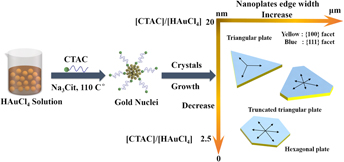Crossref Citations
This article has been cited by the following publications. This list is generated based on data provided by
Crossref.
Liu, Yanting
Yang, Lijun
and
Shen, Yajing
2018.
Hydrothermal synthesis of gold nanoplates and their structure-dependent LSPR properties – CORRIGENDUM.
Journal of Materials Research,
Vol. 33,
Issue. 20,
p.
3537.
Qiu, Jiaoyan
Li, Zihou
Miao, Lijing
Wang, Hongsen
Zhang, Yuenan
Wu, Shasha
Zhang, Yujie
Li, Xing
and
Wu, Aiguo
2019.
Colorimetric detection of Ba2+, Cd2+ and Pb2+ based on a multifunctionalized Au NP sensor.
The Analyst,
Vol. 144,
Issue. 17,
p.
5081.
Boatemaa, Mercy Adusei
Ragunathan, Ramachandra
and
Naskar, Jishnu
2019.
Nanogold for In Vitro Inhibition of Salmonella Strains.
Journal of Nanomaterials,
Vol. 2019,
Issue. ,
p.
1.
Muniba
Naz, Gul
Anjum, Muhammad Naeem
Irfan, Muhammad
Irfan, Masooma
Arshad, Muhammad
Bajwa, Sadia Z.
and
Khan, Waheed S.
2020.
Quats stabilized gold nanospheres for efficient ligand exchange procedure.
Results in Materials,
Vol. 5,
Issue. ,
p.
100065.
Vinay, S.P.
Udayabhanu
Nagaraju, G.
Chandrappa, C.P.
and
Chandrasekhar, N.
2020.
Hydrothermal synthesis of gold nanoparticles using spider cobweb as novel biomaterial: Application to photocatalytic.
Chemical Physics Letters,
Vol. 748,
Issue. ,
p.
137402.
Backes, Indra K.
González-Garcı́a, Lola
Holtsch, Anne
Müller, Frank
Jacobs, Karin
and
Kraus, Tobias
2020.
Molecular Origin of Electrical Conductivity in Gold–Polythiophene Hybrid Particle Films.
The Journal of Physical Chemistry Letters,
Vol. 11,
Issue. 24,
p.
10538.
Gautam, Anurag
Komal, Pragya
Gautam, Prabhat
Sharma, Ashutosh
Kumar, Neeraj
and
Jung, Jae Pil
2021.
Recent Trends in Noble Metal Nanoparticles for Colorimetric Chemical Sensing and Micro-Electronic Packaging Applications.
Metals,
Vol. 11,
Issue. 2,
p.
329.
Sarfraz, Nafeesa
and
Khan, Ibrahim
2021.
Plasmonic Gold Nanoparticles (AuNPs): Properties, Synthesis and their Advanced Energy, Environmental and Biomedical Applications.
Chemistry – An Asian Journal,
Vol. 16,
Issue. 7,
p.
720.
Farkas, Szabolcs
Holló, Gábor
Schuszter, Gábor
Deák, Ágota
Janovák, László
Hornok, Viktória
Itatani, Masaki
Nabika, Hideki
Horváth, Dezső
Tóth, Ágota
and
Lagzi, István
2021.
Reaction–Diffusion Assisted Synthesis of Gold Nanoparticles: Route from the Spherical Nano-Sized Particles to Micrometer-Sized Plates.
The Journal of Physical Chemistry C,
Vol. 125,
Issue. 47,
p.
26116.
Kumar, Neeraj
Chamoli, Pankaj
Misra, Mrinmoy
Manoj, M. K.
and
Sharma, Ashutosh
2022.
Advanced metal and carbon nanostructures for medical, drug delivery and bio-imaging applications.
Nanoscale,
Vol. 14,
Issue. 11,
p.
3987.
Navarrete, A.
Solís, R. R.
and
Muñoz-Batista, M. J.
2022.
Chemical Valorisation of Carbon Dioxide.
p.
308.
Chavva, Suhash Reddy
Bhat, Namratha
San Juan, Angela Michelle T.
Jaitpal, Siddhant
and
Mabbott, Samuel
2022.
Simultaneous Thermal and Spectroscopic Screening of Morphologically Complex Theranostic Gold Nanoparticles.
Journal of Nanotheranostics,
Vol. 3,
Issue. 2,
p.
102.
Zhang, Xuehua
Liu, Shun
Bi, Yang
Zhang, Pei
Lv, Liangwei
Zhang, Yaqi
Zhang, Wei
and
Hu, Fangren
2022.
Fabrication of Biomimetic Lotus Leaf Film of Zno by a Two-Step Method of Uv Imprint and Hydrothermal Growth for Superhydrophobic Applications.
SSRN Electronic Journal ,
Ali, Faisal
Hamza, Muhammad
Iqbal, Munawar
Basha, Beriham
Alwadai, Norah
and
Nazir, Arif
2022.
State-of-art of silver and gold nanoparticles synthesis routes, characterization and applications: a review.
Zeitschrift für Physikalische Chemie,
Vol. 236,
Issue. 3,
p.
291.
Putri, Kirana Yuniati
Herbani, Yuliati
Imawan, Cuk
and
Djuhana, Dede
2023.
Femtosecond laser-induced photochemical synthesis of anisotropic gold nanoparticles using geometric focusing.
Vol. 2808,
Issue. ,
p.
060003.
Zhang, Xuehua
Wang, Zhongjie
Liu, Shun
Chen, Jing
Zhang, Wei
and
Hu, Fangren
2023.
Fabrication of biomimetic lotus leaf film of ZnO by a two-step method of nanoimprint and hydrothermal growth for superhydrophobic applications.
Journal of Sol-Gel Science and Technology,
Vol. 108,
Issue. 1,
p.
73.
Liu, Haiquan
Zhang, Yue
Xiong, Weiqing
and
Wang, Xiaoyan
2023.
Aggregation-induced enhancement of peroxidase-mimetic activity of DNAzyme-gold nanoparticles for ultrasensitive detection of lead ions.
Analytical Methods,
Vol. 15,
Issue. 37,
p.
4972.
Hu, Jiansheng
Sun, Danli
Feng, Qinhui
Wei, Liang
and
Liu, Wucai
2023.
Early Detection of Carcinoembryonic Antigen Using Hollow Nanospheres Improves the Outcome of Pediatric Solid Tumors.
Journal of Biomedical Nanotechnology,
Vol. 19,
Issue. 11,
p.
1882.
Nyembe, Sanele
Mkhohlakali, Andile
May, Bambesiwe
and
Mhlanga, Nikiwe
2023.
Plasmonic Nanostructures - Basic Concepts, Optimization and Applications.
Shi, Zuolin
Chen, Mengjia
Chen, Ligang
Zou, Zheng
Gong, Shun
and
Liang, Guobiao
2023.
Enhancing Glioma Treatment by Using Novel Cryptotanshinone-Loaded Nano-Liposomes.
Journal of Biomedical Nanotechnology,
Vol. 19,
Issue. 12,
p.
2252.


